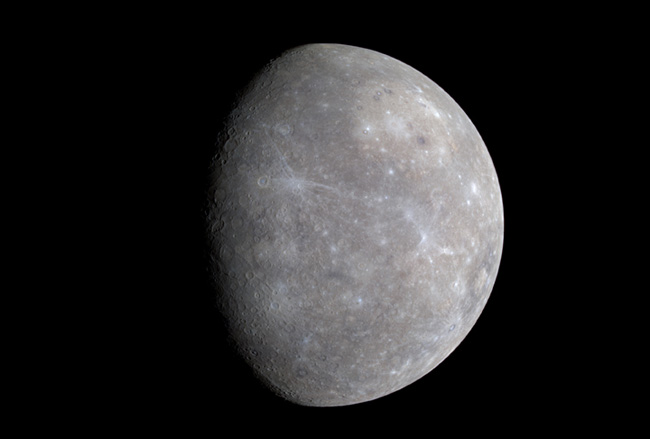Mercury's Mysteries, Old and New

Mercury, named after the mercurial god of trade who movedswiftly from place to place, has always been just out of scientists' reach.
The elusive planet is hard to glimpse from Earth, as itbarely rises above the horizon, and it has received far less attention fromNASA probes than its flashy cousins, Jupiter, Saturn and Mars.
Many scientists hope enigmatic Mercury will finally revealits secrets through data sent back by NASA's MESSENGERspacecraft, which flew by the planet Jan. 14, but so far the probe has onlyexposed new mysteries.
The mission uncovered strange differences between Mercury'scraters and the moon's, puzzling facets of its improbable atmosphere andmagnetic field, and an unexplained feature called "thespider," the likes of which scientists have never encountered before.
Misunderstood Mercury
Mercury has confused scientists since they first observedit.
When ancient Greek astronomers saw it rising briefly atsunrise and sunset, they thought the planet was two different objects, namingthe morning body Apollo and the evening appearance Hermes. It wasn't until the5th century B.C. that Pythagoras suggested the two were one.
Get the Space.com Newsletter
Breaking space news, the latest updates on rocket launches, skywatching events and more!
For a long time, scientists believed the same side ofMercury always faced the sun, similar to the way the moon orbits the Earth.1960s measurements that the "dark" side of the planet was much hotterthan expected called this notion into question, and subsequent radarobservations of its orbit overthrew the theory.
Mercury's small size (it gained the title of smallest planet inthe solar system when Pluto was robbedof that distinction) and unassuming appearance have led scientists to underestimate the planet. It waslong assumed to be merely a larger version of Earth's moon, where nothing muchwas happening.
Uncovering secrets
That idea flew completely out the window when NASA's newspacecraft recently passed by Mercury. The probe revealed a "whole newplanet," said Robert Strom, a scientist on the mission team.
The spacecraft sent back 1,200 images and data from sevenonboard instruments that show the planet is no moon-wannabe,but a dynamic place with secrets of its own.
This bizarre world is the only other inner solar system planetbesides Earth to have a magnetic field. Scientists suspect the magnetospheremight be caused by the equally strange presence of an extremely dense iron corethat accounts for two-thirds of Mercury's mass.
The magnetosphere, in turn, seems to play a part in drawinga tenuous atmosphere onto the planet, unusual for a small globe whose gravityis not strong enough to retain an atmosphere on its own. The magnetic field may also be involved in creating the tails of hydrogen and sodium atoms that stream off the planet.
The discovery of an atmosphere was one of the big surprisesof the only other Earth-to-Mercury mission, the Mariner 10 probe that flew bythe planet in 1974 and 1975. Before that, scientists had assumed that Mercurywas a barren, pockmarked world just like the Moon.
Pockmarked it certainly is — its grayish surface bears thescars of millions of years worth of space rocks slamming into it. But these craters seem different than the Moon's, and somebear features unlike anything seen elsewhere in the solar system.
For one thing, craters on Mercury seem to be shallower thansimilar-sized dents in the moon, although measurements of more craters will beneeded to confirm if this is true everywhere on Mercury.
The new photos also revealed a bizarre crater surrounded byradiating cracks in the ground that the scientists have dubbed "thespider." They are unsure of what could have caused such a formation, butsuggest volcanism might have been involved.
The spacecraft's recent flyby only whetted astronomers'appetites for more information about this peculiar world.
"It was not the planet we expected," said SeanSolomon, the principle investigator of the mission. "It?s changing veryrapidly, with features that haven?t been seen on any other planet. It's a verydynamic planet with an awful lot going on."
The probe is set to make two more passes by Mercury inOctober 2008 and September 2009, before settling into orbit in 2011. Scientistsare expecting these encounters to provide even more surprising revelations.
"The best is yet to come," mission member Stromsaid. "What you're seeing here is just the tip of the iceberg. I am very excited."
- Top 10 New Mysteries of Mercury
- VIDEO: MESSENGER at Mercury
- IMAGES: Explore the Planet Mercury
Join our Space Forums to keep talking space on the latest missions, night sky and more! And if you have a news tip, correction or comment, let us know at: community@space.com.

Clara Moskowitz is a science and space writer who joined the Space.com team in 2008 and served as Assistant Managing Editor from 2011 to 2013. Clara has a bachelor's degree in astronomy and physics from Wesleyan University, and a graduate certificate in science writing from the University of California, Santa Cruz. She covers everything from astronomy to human spaceflight and once aced a NASTAR suborbital spaceflight training program for space missions. Clara is currently Associate Editor of Scientific American. To see her latest project is, follow Clara on Twitter.










